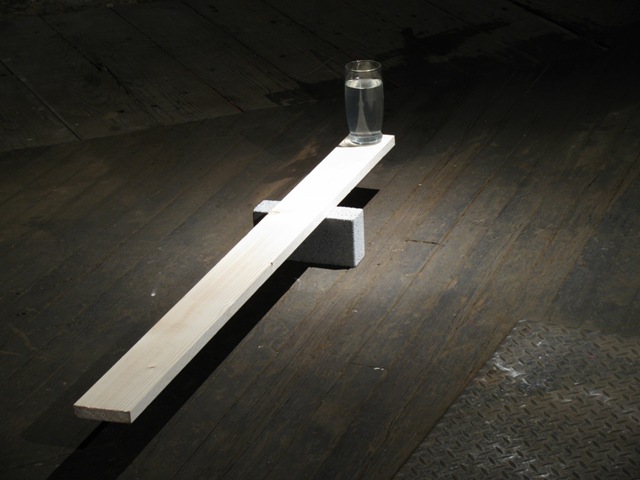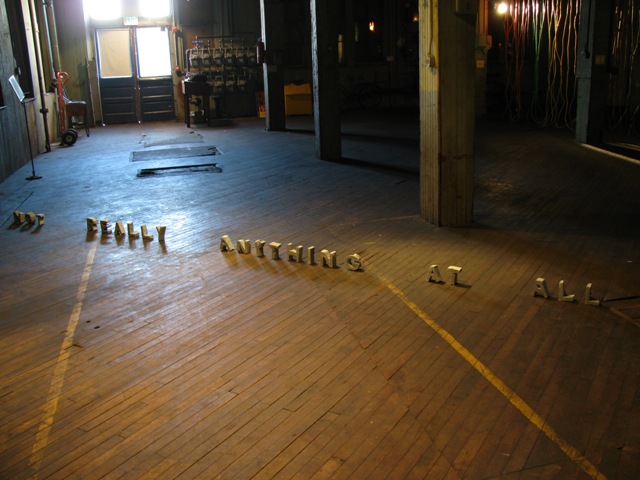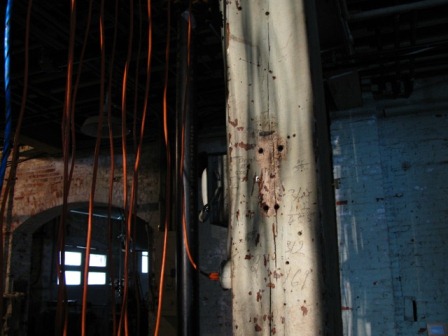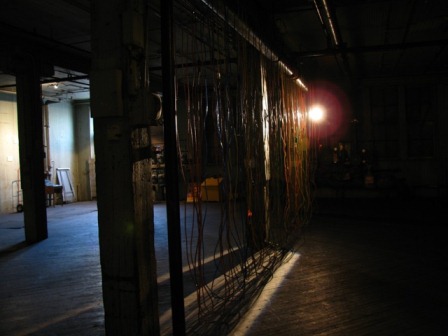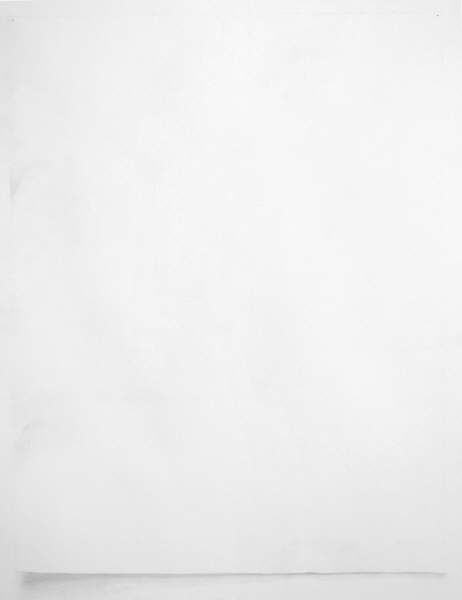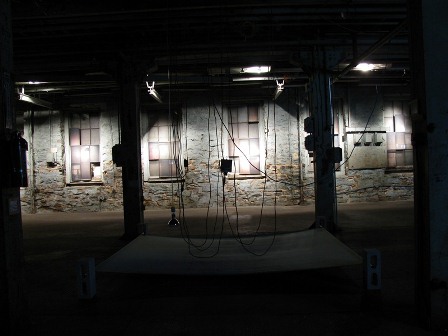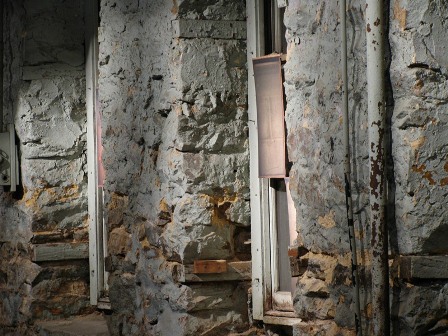Propositions A Placeless Space stephen garrett dewyer PDF Version
A proposition utters a subject in absentia of a predicate. It designates a placeless space before its enactment by the coupling of predicate and proposition within the copula. Propositions make their subject present and call for wise deliberation to determine the more virtuous proposition. Such propositions perform to outlive their original performance following their reception by others. The art of propositions lies in their becoming virtuosos. If a place designates a certain occupation of the subject within a position that predicates the exclusion of that subject from occupying other positions, the absence of place ends any certain occupation of the subject by locating a space between positions. This third space becomes present. In this way, the proposition functions like the Rabelaisian rogue, clown and fool who:
This essay intends to analyze the various usages of propositions, first, by investigating the history of the word “proposition;” secondly, by investigating the work of Neal Reinalda, Ding Ren, Glenn Shrum and Elena Volkova in the exhibition Propositions, which this essay accompanies; and, thirdly, by investigating the implications of such propositions. a proposition There appear two definitions for the word “proposition.” As a verb, proposition, from the Latin proposition, “to set forth,” suggests an offering of sex. As a noun, proposition comes from the Latin word pr The copula consummates a proposition and predicate. The eroticism present in a proposition refers to what Gayatri Chakravorty Spivak, literary theorist and professor at Columbia University, calls the copula in order to perform. The proposition requires the copula in order to enact itself in a third space between positions, between predicate and proposition, between occupation and emancipation, between labor and capital. In her analysis of Virginia Woolf’s To the Lighthouse, Gayatri Spivak writes:
That copulation happens not only in language but also between people means that the “setting out in words” is most advantageous when considering the space between reception and enactment. Like laughter (Paolo Virno, philosopher, semiotician and Marxist figurehead, makes note of this in Multitude: Between Innovation and Negation), a “setting out in words” requires a third space for its enactment. Propositions are unhomely. They perform in the unconscious space of the copula. They are ephemeral and differ from statements, which describe a ground to cover. Homi K. Bhabha, post-colonial theorist and professor at Harvard, writes:
According to Bhabha, the address of the “I and the You,” which are mimetic counterparts, undergoes a transition in a third space of becoming other. This third space, the copula, lies between activity and passivity. Aristotle briefly discusses propositions. For him, the subject of a proposition authenticates a predicate through either its affirmation or denial. Propositions are given the task of verifying the “Truth” of predicates. He thus subordinates the proposition’s relation to the predicate, which, nevertheless, excludes it from its operation. What keeps us from turning this around, whereby the predicate becomes subordinate to a proposition? The Aristotelian logic that gives propositions the task of determining the truth or falsity of predicates also must claim an original predicate, which precedes any proposition that would either affirm or deny its existence. Thus Aristotle gives the subject of a proposition the impossible task of verifying a predicate which it can neither affirm nor deny since it has been excluded from the start of the process. Western tradition has sought to occupy the subject of a proposition with an original object (such as a “Truth” of truth that would naturalize the West’s colonization of the other) by assigning the proposition the role of either affirming or denying an original predicate. Scholastic philosophy in the fourteenth century attempted to embed propositions with an object by giving the proposition a nominal significance as the ‘bearer’ of an objective entity, which, nevertheless, becomes a predicate. The most explicit assault on propositions occurs in American analytic philosophy in the mid-twentieth century. W.V. Quine, American analytic philosopher, sought to categorically deny the effectiveness of propositions by declaring “that the indeterminacy of translation prevented any meaningful discussion of propositions” (http://en.wikipedia.org/wiki/Proposition). Quine advocated for the use of sentences instead. Strawson, another American analytic philosopher, preferred the term statement over proposition, ignoring the proposition by cloaking it in the address of the statement. If the indeterminacy of the translations for the word “proposition” make its exact definition a point of contention and, thus, according to Quine, useless, why does Quine not disavow the usefulness of other words that have contentious translations as well? From these two definitions of proposition: (1) an offering of sex and (2) to set forth, there is no mention of truth or falsity. Instead, the proposition identifies a subject absent a predicate. This subject of a proposition locates a placeless space that requires the copula for the proposition to perform. Not just any proposition will do. propositions in propositions How does art propose an image for consideration by a subject? Before analyzing propositions in works by Neal Reinalda, Ding Ren, Glenn Shrum and Elena Volkova, it is imperative to answer this question since their work supports itself chiefly as art. Yet, looking at art isolated from an event will not make way for a possible answer to this question. It is necessary to recognize their work as part of an exhibition in a gallery that is part of a network of art institutions that support certain works of art. In this context, it may be seen how their work may propose anything different from what came before it and what the implications of these propositions are. the art-image The mimesis and poiesis apparent in the art-image distinguishes it from other images. This image becomes subject to dissemination and the play of dialectical and symbolic ordering that occurs between the configurations of images. This play of dialectical and symbolic ordering follows an ethical and, therefore, political, juncture. The art-image proposes new images by which to locate subjectivity between simulation and dissimulation; semblance and dissemblance; activity and passivity; logic and pathos according to an economy of its dissemination. Art proposes an image counter to another image. According to Jacques Rancière, Marxist philosopher, this image becomes aesthetic by performing three operations in different regimes: (1) the mimetic regime, (2) the poetic regime, and (3) the ethical and, thus, political regime. As previously stated, the first and second regimes distinguish it as art. In the mimetic regime, art is a “principle that isolates, within the general domain of the arts (ways of doing and making), certain particular forms of art that produce specific entities called imitations” (Rancière, Jacques, The Politics of Aesthetics, P. 21). The poetic regime classifies certain ways of making and doing (poiesis) with ambivalence to a particular end product. Genres, for instance, perform different poetic functions. In the ethical and, thus, political regime “’art’ is not identified as such but is subsumed under a question of images” (Ibid, p. 20). These three regimes define the state of the nature of aesthetics. Rancière writes:
I propose that the art-image comes not only out of an auto-erotic drive to project images in material, but, also, for the purpose of propositioning the copulation that occurs between images on the surface (copula) via dissemination. At the same time, however, the surface reveals a play of semblance and dissemblance which shows the signifier always-already under erasure. An image performs dialectical and symbolic operations which become part of its aesthetic. The dialectical operation presents a conflict over whether image a or image b better resembles image c. The symbolic operation determines which parts of image a and image b should meet to form image c. The dialectical operation shows that two images are in conflict with one another, determining which image better represents a subject. Paradoxically, whatever determination the dialectical operation performs, it mimics the subject it represents, leaving space open for other representations. However, the symbolic operation abbreviates different images for the purpose of determining the presence and absence of images in other images. Rancière gives this description of the symbolic operation:
Whereas the dialectical play of images hinges on a clash between metaphors, the symbolic play of images abbreviates images to determine a contiguous ordering that hinges on the use of a metonym. The art image proposes new forms of subjectivity and new actions that the subject performs. It distinguishes itself from other images in a poetic and mimetic performance. Nevertheless, the art-image performs a dialectical and symbolic operation as an image among other images. It becomes possible to analyze the propositions in the Ding, Elena, Glenn and Neal’s work from this premise. proposing performances for virtuosos Almost all of the works in Propositions are site-specific. Their removal from their site would no longer constitute the work as such. Much of the work mimics its exact location to the extent that the edges of the work become as important as any distinction of an interior and exterior space. Thus, the work in Propositions proposes a play of semblance and dissemblance in what appears contingent on almost entirely an aleatory encounter. The work in Propositions does not attempt to perform a tautology of textuality, which would confuse mimicry with ethics in proposing repetition and sameness as always a purely additive process. Instead, these artists’ work appropriates images in a process that substitute one image for another, never meeting in the same place. Works in Propositions propose performancesfor virtuosos. Paolo Virno, Marxist theorist and semiotician, writes that a virtuoso is “a memorable performance” and that:
These works play with the semantics of space to investigate the various usages of signs such as light and shadow, edges and boundaries, symbols and indexes, line and chance in order to develop syntax that propose a performance for a virtuoso. Their work does not attempt to transcend the space therein. Instead, their work locates amongst a variable play of other signs. Ding Ren dissembles the grand, symbolic narratives of nation-states by locating them in the found, inconspicuous cartographies of paint chips on the gallery walls in The Map Is Not The Territory, 2009 (fig. 1). Ding also locates maps of lakes, states and a province next to discreet signs of decay along the gallery walls. An etymology of each location name accompanies each respective map. These etymologies often derive from a hybrid of different dialects. That these inconspicuous spaces have no place on a map dissembles orientations with binaries such as North and South, East and West. Ding Ren collapses such ideas of distance by upending notions of being either here or there. Homi K. Bhabha, postcolonial theorist and professor at Harvard University, writes that territory is "[e]tymologically unsettled, 'territory' derives from both terra (earth) and terrēre (to frighten) whence territorium, a place from which people are frightened off" (Bhabha, Homi K., The Location of Culture, p. 142). If maps define places by their boundaries within a territory, Ding’s investigations into location and the approximate relationship of the here and there when referring to the present produce the effects of a placeless space of a boundless territory. Ding’s work shows the process of defining boundaries as an opaque affair and not a matter of producing clear and transparent boundaries. The Map Is Not The Territory plays with the potentially boundless repetition of boundaries. Figure 1
Ding Ren proposes “A PROPOSITION STARTS WITH A LINE” in Line Research (Propositional Version), 2009 (figs. 2-4). The words formed by rub-on-letters atop a pencil drawn line project onto the wall via a slide projector. The line appears broken by the protruding walls of the gallery corner. Propping the slide projector are books or “propositional texts” in which the writer for this essay did research for the exhibition Propositions and emailed Ding the bibliography. The writing on the line resembles the spines of the books used to prop the slide projector. Figures 2-4
Neal Reinalda places a glass of water on one end of a plank that lies on a brick in One Act Play, 2009 (fig. 5) in a corner of the gallery. The weight of the plank shifts as the water evaporates from inside the glass. It may or may not fall. In another corner, Neal arranges blocks of Styrofoam letters covered with faux-rock spray-paint on the floor near the walkway between one gallery space and another gallery space in NOT REALLY ANYTHING AT ALL, 2009 (fig. 6). These letters read “NOT REALLY ANYTHING AT ALL.” The disavowal of “ANYTHING AT ALL” from becoming “REALLY” just anything satirically addresses the metaphysical closure in Western metaphysics whereby the reading of a text must also ascribe a nominal value of either having been written a “truth” of truth or of a becoming “really” reality. Similar to Derrida’s reading of “do not read this,” NOT REALLY ANYTHING AT ALL implies an always-already process of writing in which nothing and anything appear ready at hand. Figure 5
Fig. 6
Figure 7
Neal Reinalda’s work traces the uncanny appearances of everyday objects. His work demands a curious eye in countering the spectacle of commodity fetish in consumerism. If capitalism attempts to homogenize space by occupying the gaze with its projection and fixing it upon a center and symbolic symbol of identity, the curious eye counters this effect. It finds heterogeneous events that defy the spotlight and shadow of such a projection. The capitalist gaze attempts to project the image of otherness always in the shadow of its own spotlight, which assumes a homogeneous and ambivalent space in which surveillance and reaction couple. If the spectacle is the ‘quintessence of consumerism’ as Guy Debord, Marxist theorist, states, Neal’s work proposes a space in which the mundane encounter with the everyday counters the spectacle by becoming mysterious. Glenn Shrum and Elena Volkova collaborate in Safelight, 2008, (fig. 8) and Untitled (paperscape), 2009 (fig. 9). In Untitled (paperscape), Elena draws what she calls “paperscapes” on two large sheets of paper that suspend from a metal spool once used to hold a projector screen. Elena almost indiscernibly represents the folds, creases and edges on the surface of the paper near its edges. The subject’s shadow projects onto the paper when walking in front of these drawings. Glenn’s Safelight projects light upon the subject to produce a shadow in Elena’s work, or, Elena casts the subject’s shadow in reflected light from Glenn’s Safelight— depending on how the subject sees it. Glenn Shrum adds and subtracts light using intervals that determine the difference between light and shadow. The interval implies syntax following a specific timing between the becoming absent and becoming present. In Safelight, 2008, several sources of light project onto a surface to produce a cyanotype print on canvas. One of the lights emits a light frequency which indiscernibly alters the print after the exposure. Two of the bulbs light during every other interval which is set to a timer. One of the lights exposes the surface of the cyanotype to colors that change with the increases in temperature from a filament. Extension cords surround the bulb, their shadows projecting in the adjacent gallery space. Figure 8 and 9
In Voltage Drop, 2008, (figs. 10, 11) Glenn projects light down the center of extension cords that coil around piping next to ceiling and hang to the floor. These extension cords supply electricity for the light that hits them. They look like multicolored spaghetti and have been collected from multiple suppliers. Glenn challenges perception by “the non-imagined spatial experience” (Shrum, Glenn), meaning the difference between peripheral and direct vision. Figures 10 and 11
Glenn Shrum subtracts light to locate the subject neither fully here nor there in a way that resembles Michelangelo Pistoletto’s subtraction of object parts in minus objects. Glenn’s work is as much about the difference between light and shadow as it is about the intervals which produce these effects. Glenn Shrum’s work differs from many contemporary artists using light as a principle medium. Whereas Olafur Eliasson’s structural supports (Electrical cords, lighting equipment, etc.) are made to appear secondary to the reflecting and refracting of light upon an object, Glenn subtracts the object to question any end in the supporting structure. Glenn thus raises awareness of the link between the institutions that support his work and the therein image. Whereas James Turrell’s work idealizes light, Glenn attempts to locate light as part of the encountering of aleatory material. Instead of isolating light to a single source, Glenn attempts to investigate the extension of light sources between intervals. Glenn’s work greatly resembles the work of Anthony McCall, who uses light to fluctuate images on a surface. Elena’s work locates its subject in a liminal space between something and nothing. Her work becomes a transition from semblance to dissemblance and vice versa. The image of scrap pieces of paper shown on other pieces of paper recalls an image lost through its representation. The resemblance of scrap pieces of paper on the surface of another sheet of paper reveals a tension between semblance and dissemblance through the process by which dissemblance produces another semblance of the object in question. As John E. Penny (former professor of the writer and Neal Reinalda at MICA; former MFAST professor to Glenn Shrum and Elena Volkova) artist and professor of contemporary art, art history and theory at the Maryland Institute College of Art (MICA), writes in an essay on Elena’s solo show, Elena Volkova: Waterlines (Paperwork Gallery, Baltimore, MD, February 8 - March 15, 2008), “[t]hey are citations of tenuity, lacking as they do, substance, or solidarity. Their thinness and scant perceptibility is most obvious in their relationship they maintained [sic] with their boundaries. Edges are only established in order to bring themselves into question” (Penny, John E., “Waterlines Essay by John E. Penny” http://bmoreart.blogspot.com/2008/02/waterlines-essay-by-john-penny.html). The edges thus define the supplement of an uncertain relationship between images of semblance and their dissemblance. Elena shows a liminal and ambivalent space between the semblance of paper and the dissemblance of that paper as lost, which only shows another piece of paper in its place.
Digital photo prints line the fronts and backsides of windows long since bricked-up along the perimeter of the gallery. Elena Volkova hangs prints taken of different window panes to correspond with their respective pane’s locations in Window Project, 2009 (figs. 13, 14). Several of the panes have no print at all, alluding to the facture of the illusion. The prints hang on fishing line strung like columns in front of the window frames. Where Elena has extra digital prints, she arranges them on a wall (an upturned platform). Figure 13 and 14
The work in Propositions calls for a curious eye to discern operations that counter capitalist spectacles of commodity fetish. This work does not impose a singular image. Instead, this work proposes an economy of the dissemination of images. This work proposes various and heterogeneous ways of engaging space by emancipating their subject from capitalist narratives that exploit labor for an end product. This work locates spaces in which subjects may emancipate from serving an anterior end product by performing virtuosos. propositions enacted into constitutions Having given a description of the propositional images in the works of Neal Reinalda, Ding Ren, Glenn Shrum and Elena Volkova in Propositions, such proposals for imagining space imply political consequences when coupled with their subsequent reproduction. Like how a proposition may alter a constitution upon its enactment into law by receiving the consent of the people, these artists’ works may alter production according to their ethics becoming aesthetic in their reproductions by others. The enactment of a proposition alters the constitution of a state upon receiving the consent of its people. As the people confound stereotypes, propositions that amend constitutions do not have a foreseeable end. Thus, some propositions have given new human rights while others have disavowed those rights (Proposition 8, which banned same-sex marriage in California following the 2008 election polls, serves as an example of a proposition that took away human rights when enacted into a constitution). Similar to colonialism’s use of the book (certainly The Bible was used just as much to impose English as the dominant language in some colonies as it was used to impose Christianity) to give Western languages precedence over other languages, it seems today the West imposes the authority of constitutions to give nation-states precedence over all other sovereignty. Certainly, the United States’ occupation of Iraq and Afghanistan as part of its “nation-building” efforts demonstrate this fact. Yet, despite the West’s use of constitutions to impose nation-states in areas where puppet governments (often despotic in nature) expedite the extraction of local resources for imperialist purposes, constitutions may be altered to recognize human rights and open a more democratic dialogue through the enactment of specific propositions. Propositions have the potential to depose authoritative readings of constitutions by opening democratic spaces of authorship during the amendment process, since such a process demonstrates that they are always-already being written. Propositions are timely. They require careful investigation beyond a perceivable end. The enactment of propositions may resolve or provoke conflict. If ‘conflict makes politics possible’ as León Rozitchner, Argentinean intellectual, puts it in his talk at the 1984 conference ‘Exile, War and Democracy’ (Philip Derbyshire and John Kraniauskas, “Introduction to Rozitchner,” Radical Philosophy, Issue: 152 - November/December 2008), it would be naïve to think that just any proposition can end any and all war. (León had experienced the 1983 election of Raúl Alfonsín and the ‘Pact’ of relative democracy following dictatorship in Argentina). Conflict does, after all, make politics possible by opening a space for negotiation where one side may recognize the rights of the other to co-exist. Thus, proposals for the recognition of the rights of the other’s pursuit of happiness seem inseparable from propositions for virtuosos. In the impossible event that time stops, all propositions would be indistinguishable from one another. Oddly enough, the Western tradition of logocentrism has sought such an end. As Jacques Derrida, philosopher, writes in a critique of the linguist Saussure:
The artists in propositions propose different ways of imagining space. They propose a way of identifying a shared space, a common surface, on which the images they project depose, rather than impose, notions of authority. The artists project images of their means of projection to question the validity of any perceivable end. Propositions proposes multiple images that identify a space that denies a singular position to view them. Propositions depose authoritarian positions of identity. They displace places in space by simultaneously erasing and tracing new locations, new subjectivities and new performances. Their absence of a spatial qualification makes them particularly precarious when discussing notions of “truth” and “falsity.” This makes them a good start for an exhibition interested in displacing such notions. works cited Althusser, Louis, For Marx, translated by Ben Brewster, Verso: London, 2005 Althusser, Louis, Philosophy of the Encounter: Later Writings, 1978-1987, edited by Francois Matheron and Oliver Corpet, translated and introduced by G. M. Goshgarian, Verso: London and New York, 2006 Aristotle, Nocomachean Ethics, translated and introduced by Martin Ostwald, Prentice Hall Inc.: New Jersey, 1999 M. M. Bakhtin, The Dialogic Imagination: Four Essays by M. M. Bakhtin, edited by Michael Holquist, translated by Caryl Emerson and Michael Holquist, University of Texas Press: Austin, Texas, 1981 Bhabha, Homi K., The Location of Culture, Routledge Classics: New York and London, 2004 Derbyshire, Philip and John Kraniauskas, “Introduction to Rozitchner,” Radical Philosophy, Issue: 152 - November/December 2008 Derrida, Jacques, Of Grammatology, translated and introduced by Gayatri Chakravorty Spivak, The Johns Hopkins University Press: Baltimore and London, 1997 Peirce, Charles Sanders, The Essential Peirce: Selected Philosophical Writings Volume 1 (1867-1893), ed. Nathan Houser and Christian Kloesel, Indiana University Press: Bloomington and Indianapolis, 1992 Penny, John E., “Waterlines Essay by John E. Penny” http://bmoreart.blogspot.com/2008/02/waterlines-essay-by-john-penny.html Rancière, Jacques, The Politics of Aesthetics, translated and introduced by Gabriel Rockhill, afterword by Slavoj Žižek, Continuum: London and New York, 2004 Spivak, Gayatri Chakravorty, In Other Worlds: Essays in Cultural Politics, Routledge Classics: New York and London, 1998 Virno, Paolo, A Grammar of the Multitude: For an Analysis of Contemporary Forms of Life, foreword by Sylvère Lotringer, translated by Isabella Bertoletti, James Cascaito and Andrea Casson, Semiotext(e) Foreign Agent Series: Los Angeles, California, 2004 Virno, Paolo, Multitude: Between Innovation and Negation, translated by Isabella Bertoletti, James Cascaito and Andrea Casson, Semiotext(e) Foreign Agent Series: Los Angeles, California, 2008 Woolf, Virginia, To the Lighthouse, forward by Eudora Welty, A Harvest Book, Harcourt, Inc.: New York, San Diego and London, 1981 http://en.wikipedia.org/wiki/Proposition |
||||||||||||||||||||||||||||
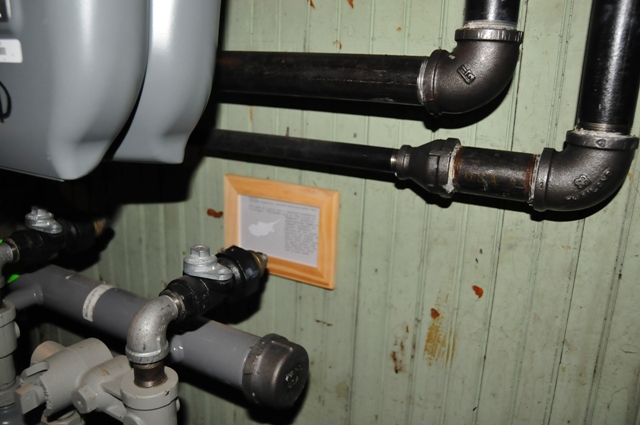
_07.jpg)
_03.jpg)
_12.jpg)
